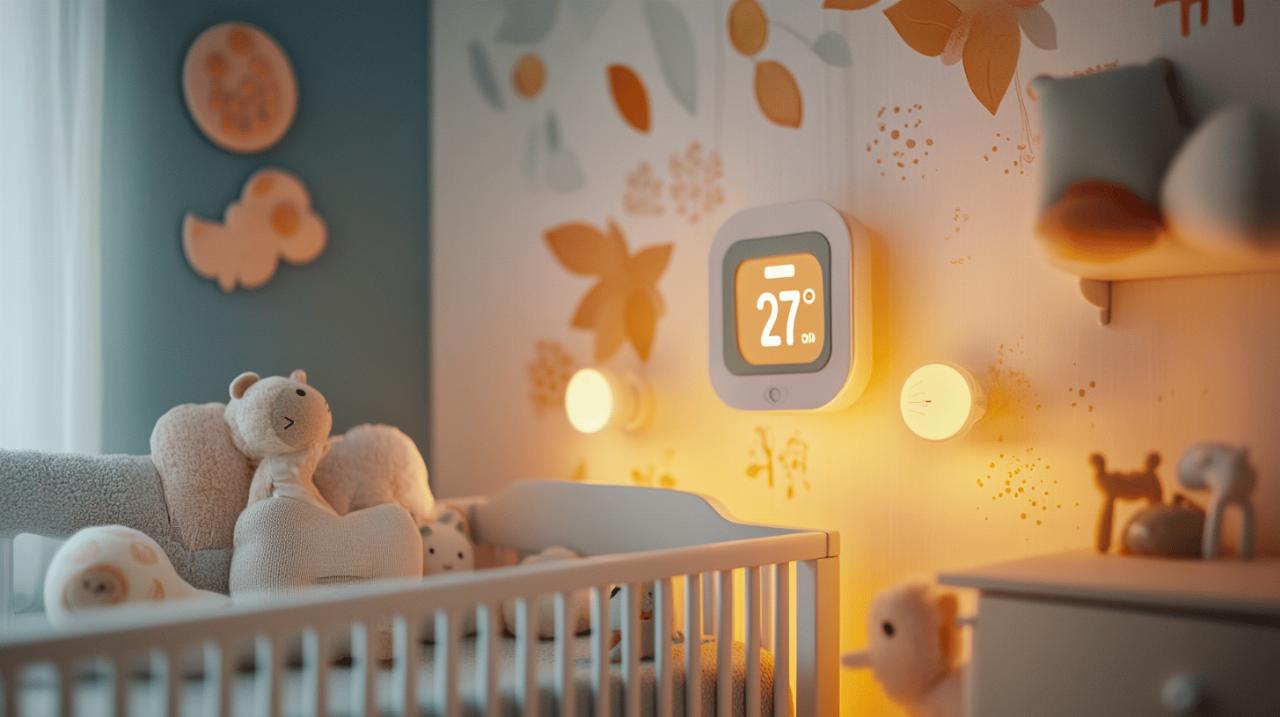Right then, let's have a look at the best temperature for a baby's room, shall we? The question we're tackling today is whether a temperature of 27 degrees Celsius is a bit too toasty for your little one. I'll give you the info straight, no messing about. When the mercury rises, many parents find themselves wondering how to keep their infants comfortable and safe, especially during those balmy summer months when even the nights can feel rather warm. Understanding the balance between comfort and safety is essential, and knowing when to employ cooling measures like air conditioning can make all the difference in ensuring your baby sleeps soundly and stays well.
Understanding the Ideal Temperature Range for Your Baby's Room
Why 16-20 Degrees Celsius is Recommended by Health Professionals
Health professionals, including those at the NHS, consistently advise that the ideal room temperature for a baby should sit comfortably between 16 and 20 degrees Celsius. This range has been carefully considered to support a baby's natural ability to regulate their body temperature, which is still developing in the early months. Babies are far more sensitive to temperature changes than adults, and their smaller bodies can struggle to maintain a stable core temperature when the environment is too hot or too cold. Keeping the nursery within this recommended bracket helps reduce the risk of overheating, which is linked to an increased chance of sudden infant death syndrome. Moreover, a cooler room encourages deeper, more restful sleep, which is vital for your baby's growth and development. Parents often worry about their little ones feeling chilly, but with appropriate sleepwear and bedding, this temperature range is both safe and comfortable. It's worth noting that babies should feel warm to the touch on their chest or back, rather than on their hands or feet, which naturally run cooler.
The risks associated with rooms above 24 degrees celsius
When the temperature in a baby's room climbs above 24 degrees Celsius, the risks of overheating begin to rise significantly. At 27 degrees, the environment is decidedly too warm for a baby to sleep safely and comfortably. Elevated temperatures can lead to dehydration, as babies lose moisture through sweating and increased respiration. Heat exhaustion becomes a genuine concern, with symptoms including tiredness, vomiting, and a persistently high temperature. In more severe cases, heatstroke can develop, which is a medical emergency requiring immediate attention. Babies may become restless, irritable, and unable to settle, as their bodies work overtime to cool down. Their skin may appear flushed, and they might feel clammy or sticky to the touch. Furthermore, prolonged exposure to high temperatures can exacerbate respiratory issues, particularly in newborns whose airways are still delicate. The body's natural thermoregulation is compromised in a hot room, making it difficult for infants to achieve the restorative sleep they need. Parents should remain vigilant and take proactive steps to bring the temperature down to a safer level, ensuring their baby's well-being is not compromised by the heat.
Recognising the Signs That 27 Degrees is Too Warm for Your Little One
Physical indicators your baby is overheating
One of the first physical signs that your baby is too hot is a flushed or reddened complexion, often accompanied by damp or sweaty skin, particularly on the chest, neck, or back. Babies may also develop small, raised spots known as heat rash, which can cause discomfort and itching. If you notice that your baby's hair is damp or their nappy area is unusually moist, these are further indicators that the room temperature is excessive. A baby who is overheating may also feel very warm to the touch on their torso, rather than just on their extremities. In some cases, the baby's breathing may become rapid or shallow, and they might appear lethargic or unusually drowsy. It's important to check your baby regularly by gently placing your hand on their chest or back, as this gives a more accurate reading of their core temperature than touching their hands or feet. If you observe any of these signs, it's crucial to take immediate action to cool your baby down by removing layers of clothing, offering fluids, and reducing the ambient temperature of the room.
Sleep Disruption and Discomfort at Elevated Temperatures
Sleep disruption is one of the most telling signs that 27 degrees is too warm for your baby's room. Babies who are too hot often struggle to fall asleep and may wake frequently throughout the night, crying or appearing restless. They may toss and turn, kick off any blankets, or seem unable to settle into a comfortable position. This discomfort is not only distressing for the baby but also exhausting for parents who are trying to soothe them. Elevated temperatures can prevent babies from entering the deeper stages of sleep, which are essential for their physical and cognitive development. Over time, chronic sleep disruption due to heat can affect a baby's mood, feeding patterns, and overall health. Parents may notice that their baby is more irritable during the day, has a reduced appetite, or seems less alert and engaged. Addressing the room temperature is a straightforward and effective way to improve sleep quality and ensure your baby is well-rested. By maintaining a cooler environment, you help your little one achieve the restorative sleep they need to thrive.
Safe and Effective Ways to Use Air Conditioning in the Nursery
Setting the Right Temperature and Airflow Direction
 When using air conditioning to cool a baby's room, it's essential to set the unit to a temperature that brings the room back within the recommended range of 16 to 20 degrees Celsius, or at least down to a more comfortable level closer to 22 degrees if a rapid cool-down is needed. Avoid setting the air conditioning too low, as a sudden drop in temperature can be just as uncomfortable and potentially harmful as excessive heat. It's also crucial to direct the airflow away from the baby's cot or sleeping area, ensuring that cold air does not blow directly onto your little one. Direct exposure to chilled air can cause discomfort, respiratory irritation, and an increased risk of catching a cold or developing other respiratory issues. Instead, aim to circulate the cool air around the room, allowing it to gently lower the overall temperature without creating a draft. Many modern air conditioning units come with adjustable vents and directional settings, which can be positioned to distribute air evenly throughout the space. Regularly checking the room temperature with a reliable thermometer will help you maintain the ideal environment and make adjustments as needed.
When using air conditioning to cool a baby's room, it's essential to set the unit to a temperature that brings the room back within the recommended range of 16 to 20 degrees Celsius, or at least down to a more comfortable level closer to 22 degrees if a rapid cool-down is needed. Avoid setting the air conditioning too low, as a sudden drop in temperature can be just as uncomfortable and potentially harmful as excessive heat. It's also crucial to direct the airflow away from the baby's cot or sleeping area, ensuring that cold air does not blow directly onto your little one. Direct exposure to chilled air can cause discomfort, respiratory irritation, and an increased risk of catching a cold or developing other respiratory issues. Instead, aim to circulate the cool air around the room, allowing it to gently lower the overall temperature without creating a draft. Many modern air conditioning units come with adjustable vents and directional settings, which can be positioned to distribute air evenly throughout the space. Regularly checking the room temperature with a reliable thermometer will help you maintain the ideal environment and make adjustments as needed.
Maintaining proper humidity levels whilst cooling the room
Air conditioning can sometimes reduce the humidity in a room, leading to dry air that may irritate a baby's delicate skin and respiratory system. To counteract this, consider using a humidifier alongside the air conditioning unit to maintain a comfortable level of moisture in the air. The ideal indoor humidity level for a baby's room is typically between 30 and 50 per cent, which helps keep nasal passages clear and skin hydrated. Ensure that the humidifier is kept clean and filled with fresh water to prevent the growth of mould or bacteria, which can be harmful to your baby's health. It's also important to offer your baby plenty of fluids during warm weather, as air conditioning can contribute to dehydration if not managed carefully. Breastfed babies may wish to feed more frequently, while bottle-fed infants can be given small amounts of cooled boiled water in addition to their usual formula. Babies over six months who have started on solids can have sips of water from a beaker or cup. By balancing the cooling effect of air conditioning with proper humidity and hydration, you create a safer and more comfortable environment for your little one.
Practical Tips for Managing Room Temperature Without Over-Reliance on AC
Natural Ventilation and Strategic Use of Curtains and Blinds
Natural ventilation is one of the most effective and energy-efficient ways to cool a baby's room when the temperature climbs. Opening windows in the early morning and late evening, when the air outside is cooler, can help bring down the indoor temperature without the need for air conditioning. Creating a cross-breeze by opening windows on opposite sides of the room encourages fresh air to flow through, dispersing heat and improving air quality. During the hottest part of the day, especially between 11am and 3pm, it's wise to keep curtains or blinds closed to block out direct sunlight, which can significantly raise the temperature inside. Blackout curtains are particularly useful, as they not only keep the room darker for better sleep but also provide an extra layer of insulation against the heat. If your home has shutters or external blinds, these can be even more effective at preventing heat from entering the room. By combining natural ventilation with strategic window coverings, you can maintain a more stable and comfortable temperature for your baby without relying solely on air conditioning, which can be costly and may dry out the air if used continuously.
Choosing Appropriate Bedding and Sleepwear for Warmer Conditions
Dressing your baby appropriately for the ambient temperature is just as important as managing the room temperature itself. In warmer weather, when the room is hovering around 24 degrees or higher, consider dressing your baby in minimal nightwear, such as a nappy and a lightweight cotton vest or sleeping bag with a low tog rating. Cotton is breathable and helps wick moisture away from the skin, reducing the risk of heat rash and discomfort. Avoid synthetic fabrics that can trap heat and make your baby feel clammy. If the temperature is particularly high, some parents find that dressing their baby in just a nappy is sufficient, provided the room is safe and free from drafts. It's important to check your baby regularly throughout the night to ensure they are not too hot or too cold, adjusting their clothing as needed. Bedding should also be kept to a minimum during warm weather, with a single light sheet or no covering at all if the room is very warm. Heavy blankets, duvets, and additional layers should be removed to prevent overheating. Running a cool bath before bedtime can help lower your baby's core temperature and make settling down for the night more comfortable. By carefully selecting sleepwear and bedding, you can help your baby stay cool and sleep soundly, even when the mercury rises.

